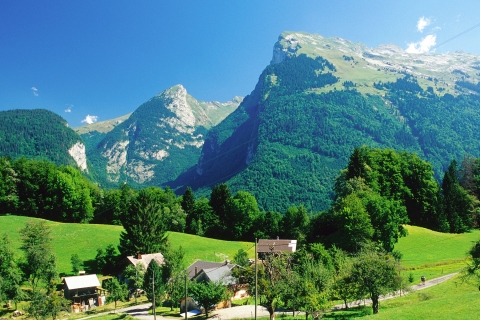Veyrier-du-Lac Temperatures: Monthly Averages and Year-Round Insights
On this page, weâll explore Veyrier-du-Lacâs temperature statistics in detail, including day and night variations and monthly averages. Weâll also compare the annual temperature to other cities in France.
Monthly Temperature Averages
In Veyrier-du-Lac, temperatures can shift dramatically between warm in summer and cold in winter. Typically, maximum daytime temperatures range from a warm 24ÂḞC in July to a cold 5ÂḞC in the coolest month, January. Nights are cooler, with temperatures generally dropping to -4ÂḞC, particularly during the colder months.
The chart below illustrates the average maximum day and minimum night temperatures in Veyrier-du-Lac by month:
The minimum temperature is often recorded between 4 AM and 6 AM, while the highest temperature is usually reached at 3 PM. During this time the sun's heating effect is the strongest. July, the cityâs warmest month receives 275 hours of sunshine.
The chart below shows the average temperature throughout the year:
January, the cityâs coldest month, sees about 134 mm of rainfall spread over roughly 14 days. It records 92 hours of sunshine of sunshine.
Annual Temperatures in France Compared
The map below shows the annual temperature across France. You can also select the different months in case you are interested in a specific month.
 very warm
very warm
 warm
warm
 pleasant
pleasant
 moderate
moderate
 cold
cold
 very cold
very cold
Veyrier-du-Lac Temperatures Compared World Wide
Veyrier-du-Lacâs average annual maximum temperature is 14ÂḞC. Letâs compare this with some popular tourist destinations:
Athens, Greece, experiences an average annual temperature of 23ÂḞC, with hot summers and mild winters typical of a Mediterranean climate.
Meanwhile, Queenstown, New Zealand, the average annual temperature is significantly lower at 10ÂḞC, with mild summers and cold winters.
In Seoul, South Korea, the average annual temperature is 18ÂḞC, featuring distinct seasons.
In Brisbane, Australia, the average annual temperature is 26ÂḞC, making it warmer than Sydney.
How are these Temperatures Measured?
Generally, temperature data depicting climate is usually given over a 30-year average in order to reduce short-term fluctuations and reveal better long-term trends in climate conditions.
This temperature data is taken from land-based thermometers, ocean buoys, ships, and satellites. These measurements are transmitted to weather stations and climate centers around the globe where they are processed, averaged, and analyzed in order to monitor the trends and create climate models.
Sea vs. Land Temperatures
The influence of nearby oceans or large water bodies significantly affects local temperatures:
- Ocean Influence: Coastal regions tend to have more stable temperatures, as large bodies of water absorb and release heat slowly. This often results in milder winters and cooler summers compared to inland areas.
- Continental Climates: Landmasses well away from large bodies of water tend to show greater extremes in temperature, having hotter summers and colder winters because of the absence of water as a moderating influence.
For more detailed information about Veyrier-du-Lacâs weather, including monthly rainfall, sunshine hours, and humidity levels, visit our Veyrier-du-Lac climate page.
Current temperature in Veyrier-du-Lac
clear and no rain
almost clear and no rain
almost clear and no rain




